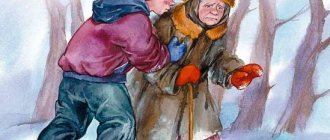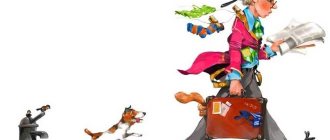1. Pronunciation of the sound [S] 2. The difference between the articulation of the sound [Z] and the sound [S] 3. Articulation of the sound [C] 4. Methods of setting the sounds [S], [Z], [C] step by step 4.1. Lip exercises 4.2. Gymnastics for the tongue 4.3. Breathing exercises 5. Second stage of production 6. Automation of sounds [S], [Z], [C]. Working with cards.
Work to eliminate the shortcomings of pronouncing the sounds [С], [З], [Ц] in most cases requires lengthy and painstaking actions. The teacher needs to clearly imagine the correct articulation of these sounds.
Pronouncing the sound [S]
- the lips slightly stretch into a smile, except in those cases when the subsequent phonemes are the vowels [O] and [U], which leads to anticipatory rounding of the lips;
- the teeth are either compressed or brought together, leaving only a narrow gap (about 1-2 mm);
- the tip of the tongue rests on the gums of the lower incisors, its back is curved, and the lateral edges are adjacent to the upper molars;
- along the tongue, in its middle, a groove is formed, which at the alveoli opens outwards with a narrow round hole;
- the soft palate is raised and closes the passage of air into the nasal cavity;
- The vocal cords are open and freely allow exhaled air to pass into the pharyngeal and oral cavities. The air stream is narrow, cold, strong.
Development of visuospatial orientation
L: Now let’s go to the table (they get up and go to another table that was prepared in advance). Look at our table. There are various objects on it. There is a bowl to your right, take it and give it to me. R: At first he reaches out to the elephant, but then he takes the bowl and gives it to the speech therapist L: That's right! There is an elephant (toy) to your left, take it and give it to me. R: takes the elephant and gives it to the speech therapist. L: Right! (removes the elephant and the bowl, takes out toy boots and socks). Take the object that lies closer to you and give it to me (the boots are closer). And then take the object that is further from you (further are the socks) R: Takes the socks and gives them to the speech therapist. Afterwards he corrects himself and takes the boots, and then takes the socks and also gives them to the speech therapist. L: Well done!!
Methods for setting sounds [S], [Z], [C] step by step
As diverse as the defects in pronouncing the sounds [S], [Z], [Ts] are, the ways to overcome them are just as diverse. To produce whistling sounds, complex and precise movements of the tongue are required, which involve the tip of the tongue, the lateral edges of the tongue, and the back of the tongue. Also necessary are precise movements of the lips (in a smile), the lower jaw (barely lowered) and the presence of an air stream (sufficiently strong and moving in the middle of the tongue). To develop the necessary movements of the lips and tongue, a series of articulation exercises should be performed.
Lip exercises
"Smile"
. Smile so that the upper and lower teeth are visible, hold this position for 5-7 seconds.
"Tube"
. Extend lips with a tube:
1st option - pronounce the sound [U] for a long time without using your voice;
2nd option - pull your lips slightly forward, as if forming a square. The teeth are closed.
"Doors Open"
. Slowly open your mouth until there is a distance of 10-15 mm between the upper and lower teeth, hold your lips in the “Smile” position.
"Bunny"
. Smile so that your upper and lower teeth are visible, raise your upper lip (wrinkle your nose), and lower it back into place.
Lower your lower lip and open your lower teeth. Lips and teeth are closed. Repeat 5-7 times.
Gymnastics for the tongue
"Pancake"
. Place a wide, relaxed tongue on the lower lip.
Make sure that the lower lip does not tense. The upper teeth should be exposed (that is, the “Smile” position is maintained). If the tongue does not take the desired shape, it is recommended to do a passive massage, pronounce syllables with the tongue sticking out between the lips, for example “ba-ba-ba”.
Upon achieving success, make your tongue wide without pronouncing these syllables and blow with a narrow cold stream of air until a groove is formed along the midline of the tongue.
"Swing"
. Raise your wide tongue over your upper teeth and then lower it behind your lower teeth. Perform the exercise counting 8-10 times.
"Let's brush our teeth"
. Smile, show your teeth, open your mouth slightly and “clean” your lower teeth with the tip of your tongue, first moving your tongue from side to side, then from bottom to top.
"Slide"
. Smile, show your teeth, open your mouth, place the tip of your tongue behind your lower incisors, pushing the middle part of the back of your tongue forward (“built a slide”).
"Monkey"
. Bite the side edges of the tongue (perform the “Gorka” exercise) and, holding the tip of the tongue behind the lower teeth, bite the side edges of the tongue on the right and left (you can pronounce “ey-ey-ey”). If this doesn’t work, then pronounce the sound “i-i-i”, stretching your lips as much as possible and holding the tip of your tongue behind your lower teeth.
"Pussy is angry"
. Smile, show your teeth, open your mouth, place the tip of your tongue behind your lower incisors, arch your back and stroke it with your upper teeth. In this case, you need to make sure that the lower teeth do not move forward.
“High slide - low slide”
. Lower the tip of the tongue behind the lower teeth, pushing the middle part of the back of the tongue forward (“high slide”). Holding the tip of your tongue behind your teeth, pull the middle part of the back of your tongue deep into your mouth (“low slide”). Repeat 3-4 times.
Breathing exercises
"Breeze"
. Simply blow through closed lips, controlling the stream of exhaled air using a strip of paper brought to your mouth, a piece of cotton wool suspended on a thread, or simply by feeling the stream on your hand brought to your mouth.
"Put the ball into the goal"
. Stretch your lips forward with a tube and blow for a long time onto a cotton ball (lying on the table in front of the child), driving it between two cubes.
“Who will kick the ball further?”
Smile, place the wide front edge of the tongue on the lower lip, as if pronouncing the sound [F] for a long time, blow the cotton wool onto the opposite edge of the table. The lower lip should not be pulled over the lower teeth. Make sure that the child does not puff out his cheeks and pronounces the sound [F], not [X].
"Singing Bubble"
. The exercise is done in front of a mirror with the tongue stuck wide between the lips, its lateral edges adjacent to the corners of the mouth. A longitudinal groove should form in the middle of the tongue. Holding the vial (test tube) vertically, you should bring its hole to the middle part of the front edge of the tongue. If, at the moment of blowing, a groove is formed along the tongue, along which an air stream rushes, then when the bubble (test tube) is brought to the tongue, a strong noise should be heard, which indicates the correct alignment of the tongue.
"Focus"
. Smile, open your mouth slightly, place the wide front edge of your tongue on your upper lip so that its side edges are pressed and a groove is formed in the middle, and blow off the cotton wool placed on the tip of your nose. The air should go in the middle of the tongue, then the fleece will fly up.
Development of visual perception and fine motor skills
L: Let's play a game called "Which picture is missing?" — There are pictures in front of you: Snowman, Sledge, Elephant, Table. - Remember these pictures. When you remember them, “night” will begin and you will close your eyes. - When I say “day”, you will have to open your eyes and say which of the pictures is gone. - “Night” (The speech therapist removes the picture with the snowman). - "Day". Open your eyes. -What picture is missing? - The snowman is missing! (The speech therapist puts the picture of the snowman with the other pictures) - Try to remember all the pictures again: Snowman, Sleigh, Elephant, Table - “Night” (The speech therapist removes the picture with the elephant). - "Day". What picture is missing? - Right! (The speech therapist puts a picture of an elephant with the other pictures). R: Answers, completes the task, if he makes a mistake, the speech therapist helps.
Second stage of production
If the child successfully copes with all the exercises, you can begin direct sound production.
The most common techniques for setting the sound [C] are the following:
- With your mouth slightly open, show the child in front of the mirror the difference between correct and defective articulation, and depict this using your hands. Having achieved the correct position of the tongue, you can turn on the exhalation and give the child the opportunity to feel the stream of exhaled air on the hand brought to the mouth.
- The sound [T] can be used as a basis for setting the sound [C], if it is pronounced correctly. You should ask the child to pronounce the sound [T] with some aspiration. The presence of aspiration should be controlled by feeling a stream of air on the hand. Then you need to invite the child to do the same, first resting the tip of the tongue on the gums of the lower incisors. Gradually, during the exercises, the fricative part of the continuous sound lengthens and then separates, after which it can be explained to the child that this is the correct sound [C].
- In more difficult cases (with lateral sigmatism), it is important to ensure that the air stream passes through the center of the tongue, so it is necessary to pay special attention to the exercises “Breeze” and “Who will kick the ball further?”.
- Having received the required result (the formation of a groove and the passage of a jet along it), we invite the child to raise his upper lip and blow. Gradually move the tongue to a position behind the lower teeth.
- Having lowered the tip of the tongue behind the lower incisors, the child should bite the lateral edges of the tongue and blow along the center of the tongue into the crack between the teeth.
The voiced sound [Z] is easily reproduced by simply adding the voice to the phoneme [S].
When automating the sounds [S], [Z], [C] in words, one should take into account the child’s articulatory abilities, his age, the ability to master semantics, and mastery of the syllabic structure of the word.
Forms of sigmatism
Sigmatism is a defect in the pronunciation of hissing and whistling sounds, in our case “s”. There are 4 forms of violation.
The first is sigmatism itself, when “s” is absent from speech.
The second is parasigmatism, that is, when “s” is replaced with another sound.
Variants of parasigmatism:
- on “f” - labiodental;
- on “t” - toothed;
- on "sh" - hissing.
The third is the distortion of the “s” sound. There are several options: interdental (the child has a lisp, instead of “s” you hear “sh”), lateral (instead of “s” you hear “lkh”) and nasal (instead of “s” you hear a grunting or snoring sound, vowels are pronounced in a nasal voice).
The fourth is softening the hard sound “s”. It turns out like this: instead of the syllable “sa” - “sya”, “so” - “syo”, “su” - “syu”, “s” - “sya”.
Work on the syllabic structure of a word, sound analysis of syllables
L: Artem, look, I have a picture in my hands, what is drawn in this picture? Our bear Styopa loves sledding. How many syllables are in the word "sleigh"? Say the word “sleigh in syllables.” Get your hands ready, let's try to pronounce this word together: - San (clap) - ki (clap) How many syllables are in the word sani? Two. Now look, there are red, blue and green chips in front of you. Let's put the word Sankey out of these chips. • The red chip is a vowel sound. • The blue chip is a consonant sound. • The green chip is a soft consonant sound. — The first syllable in the word Sanki is San. Lay out this syllable using our chips. R: puts the red chip first, green chip second, blue chip third. L: No. Artem, let's try together to determine what chips the word Sanki consists of. — Explains to the child which chip should go behind which and why. • 1 blue chip, because the sound [s] is a consonant and a hard sound, • 2 red chip, because the sound [a] is a vowel, • 3 blue chip, because the sound [n] is a consonant and a hard sound. L: The second syllable in the word Sanki is Ki. What is the sound [k']? - Well done! What else? R: consonant, hard, voiced! L: Let's say together: - K, K, K! - The sound of K is soft, now put your hand to your throat and say again - K, K, K! - Do you feel the vibration? - So the sound [кь] is what R: k- k- k- k- k. Deaf. L: What color do we designate it with? Since he is agreeable and soft? R: Green! L: Correct, what is the sound? What color do we use to represent it? R: Vowel, red! L: Right, now try to spell out the syllable Ki with chips. R: • 1 chip is green, because the sound [k'] is consonant and soft, • 2 chip is red, because the sound [i] is a vowel. L: Well done, that's right!
Homework
L: Artem, Styopa asks you to cut out beautiful snowflakes from paper at home and decorate the house with them.
Bottom line
L: Today the bear Styopa found a new friend, he really liked playing with you. What sound does Styopa's name begin with? R: From the sound [s]! L: Right! What is the sound [s]? R: consonant, hard, deaf!
Performance evaluation
L: Well done. Styopa really enjoyed playing with you, but it’s time for him to go home to his forest friends. He says goodbye to you. You can go too! R: Goodbye!
Related posts:
- What is "War and Peace" about? Summary of the novel “War and Peace” by chapters. All answers...
- P.P. Ershov “The Little Humpbacked Horse” - summary of “The Little Humpbacked Horse” by P.P. Ershov - a very brief summary for the reader...
- I.S. Turgenev “Mumu” “Mumu” I.S. Turgenev: read the story ONLINE without registration. The work in its entirety...
- What do we know about Morse code? Morse code was created to transmit short information. But use...
Development of phonemic processes
L: Now let's play the game "Recognize the sound." There are different objects in front of you: a spoon, a glass, paper. Now I will show you how sound is produced by each object, and you remember this. The speech therapist taps the glass with a spoon, then rustles the paper. - Now close your eyes, I will make sounds, and then you will show me what object I used to make this sound. The speech therapist knocks a spoon on a glass and rustles paper. Plays sounds again so that the child remembers them. R: closes his eyes and then recognizes sounds; if there are mistakes or difficulties, the speech therapist helps.
How to teach a 3-4 year old child to pronounce the whistling sounds S and Z correctly? Video
If a child is good at articulatory gymnastics movements, then, as a rule, a few simple techniques will allow him to almost immediately learn how to correctly pronounce the whistling sounds s and z. You will learn how you can teach your child at home to correctly pronounce the sound s and correct its pronunciation from Irina Denisova’s video. She shares some professional speech therapy secrets with her parents.
If you managed to successfully evoke a sound, then all that remains is to automate its correct pronunciation in syllables, words and phrases. You can learn about games and exercises for automating the sounds C and Сь in a child’s speech in the article
"Automation of whistling sounds С and Сь"
If a child’s pronunciation of many sounds is impaired, he finds it very difficult to do articulation exercises, and cannot produce the “correct” sound, then you definitely need to contact a speech therapist at a children’s clinic or speech therapy kindergarten. You can always find out the addresses of all institutions where you can get help from a speech therapist free of charge from your district or city education department.
And at the end of the article there are several songs for speech lessons with children based on the sound s.







